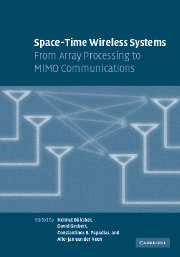Book contents
- Frontmatter
- Contents
- List of contributors
- Acknowledgments
- Introduction
- Part I Multiantenna basics
- Part II Space-time modulation and coding
- Part III Receiver algorithms and parameter estimation
- 12 Array signal processing
- 13 Optimal subspace techniques for DOA estimation
- 14 Blind and semiblind MIMO channel estimation
- 15 MIMO receive algorithms
- 16 Space-time turbo coding
- 17 Training for MIMO communications
- Part IV System-level issues of multiantenna systems
- Part V Implementations, measurements, prototypes, and standards
- Index
14 - Blind and semiblind MIMO channel estimation
Published online by Cambridge University Press: 25 February 2010
- Frontmatter
- Contents
- List of contributors
- Acknowledgments
- Introduction
- Part I Multiantenna basics
- Part II Space-time modulation and coding
- Part III Receiver algorithms and parameter estimation
- 12 Array signal processing
- 13 Optimal subspace techniques for DOA estimation
- 14 Blind and semiblind MIMO channel estimation
- 15 MIMO receive algorithms
- 16 Space-time turbo coding
- 17 Training for MIMO communications
- Part IV System-level issues of multiantenna systems
- Part V Implementations, measurements, prototypes, and standards
- Index
Summary
The goal of this chapter is to expose a number of key ideas in blind and, especially, semiblind (SB) channel estimation (CE), and attract attention to various considerations that should be kept in mind in this context. As will become clear, the topic considered is vast. Due to space limitations, the inclusion and discussion of references is far from exhaustive. See also de Carvalho and Slock (2001) for an overview of semiblind single-input multiple-output (SIMO) channel estimation approaches. The use of blind information in digital communications is motivated by a desire to limit capacity loss due to training. Such capacity loss potentially increases with increasing time variation, occupied bandwidth, and number of transmitters. In other applications, blind techniques may be the only option (e.g., acoustic dereverberation). A particularity of digital communications, however, is that the sources are discrete time, white, and finite alphabet.
Signal model
In a first instance, the nonblind information considered will be provided by training or pilot information. As for terminology, the term training sequence (TS) tends to be used for a limited consecutive sequence of known symbols, whereas pilot symbols are typically isolated known symbols. A pilot signal is a continuous stream of known symbols, superimposed on the data signal.
- Type
- Chapter
- Information
- Space-Time Wireless SystemsFrom Array Processing to MIMO Communications, pp. 279 - 301Publisher: Cambridge University PressPrint publication year: 2006
- 4
- Cited by



